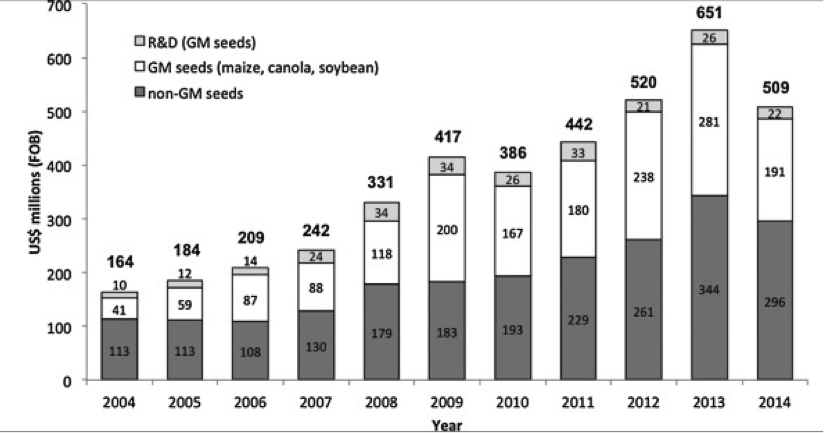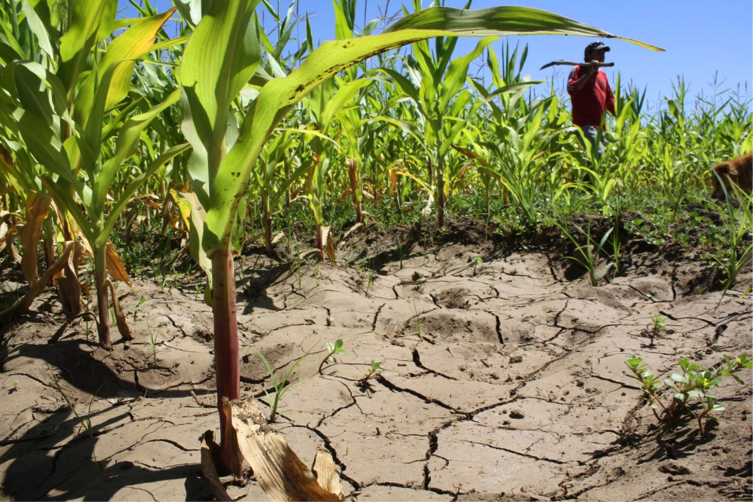Probably you have not heard much about Chile, a country historically isolated in the extreme south of the world in South America. Maybe you’ve heard about the earthquakes we usually face, our good wines, the goals of Alexis Sanchez in the European soccer, or the varied natural and beautiful landscapes throughout the country.
But along with its copper and other minerals, fish, fresh fruits and wine, Chile has a surprising export crop: seeds. It is currently the fifth largest seed producer worldwide, and the first in the production of genetically modified (GM) seeds in the southern hemisphere.
Though it s a top GM seed exporter, Chile still doesn t allow its own farmers to use the technology.
Access to GM crops is strictly regulated and allowed only for export seed production and controlled reproduction of seed associated with research and field testing purposes. Commercial cultivation is not authorized.

Chile s GMO contradiction
Several private companies have invested a lot of money in winter nurseries and research programs for GM seeds over the last decade in Chile, due to its favorable geographic and weather conditions along with regulatory and political stability. In this way, when the breeders in the Northern Hemisphere are in winter, they can speed up their research programs by sending GM seeds for field evaluations in Chile, where it s summer. This allows them to develop the next generation of crops in a shorter period of time.
The area planted with GM seeds for export (corn, soybean and canola) in Chile varies according to the needs of the markets that demand GM seed. If countries from the Northern Hemisphere, such as the US, have a season with high yields, then their companies will request less seed production from the Southern Hemisphere nations. Conversely, when environmental factors such as drought and the attack of pests adversely affect agricultural production yields in the Northern Hemisphere, then the demand for production of GM seeds in countries like Chile increases.
Field trials of GM crops have been carried out since 1987, when the first environmental release was authorized in Chile. Currently there are field tests with such GM crops as corn, canola, soybean, safflower, tomato, sugar beet, mustard, rice, table grape, cotton and squash. In this way Chile provides services of research and development to other countries; in fact, more than 800 events have been tested in Chile before the commercial release in other countries.
Moreover, Chile imports GM food or ingredients for the food industry that are allowed without restrictions or labeling, and it has approved the use of GM corn and GM soy for animal feed. In fact, Chile imports most of its soybeans from Argentina, and half of the corn from Brazil and Argentina, countries that are global leaders in the production of GMOs with adoption rates higher than 90% in corn and soybean.
Are you noticing the contradiction? The Chilean framework allows everything with GMOs, except it prohibits its own farmers from using these crops in commercial production in the national market. This causes Chilean farmers to be less competitive with their colleagues in the region (Argentina, Brazil, Uruguay, Paraguay, Colombia and Bolivia), who have long benefited from this technology.
It s not just Monsanto
Many people wrongly believe that GM crops are something exclusive to big companies, forgetting that many developing countries also produce this technology in their public and private sector. In the case of Chile, since 1991 in the public sector there have been more than 32 development projects of GM crops, with more than $16.2 million dollars from state agencies for funding. Some 50% of these projects have been developed by the National Institute for Agricultural Research (INIA), an agency from the Ministry of Agriculture, 34,4% by universities and 15,6% by research centers. These projects are focused on biotic and abiotic stress resistance (and also nutrition and quality enhancement) in crops of national importance, such as corn, grapes, apple, canola and forestry products (eucalyptus, pinus and plump).
The government has invested considerable resources to fund research and development on GM crops, but the lack of clarity in the current regulatory situation precludes the use of such research to develop new GM products for Chilean farmers. In other words, the Chilean legislation is not only hurting its farmers, but its own scientists, who can t put their developments in the field at the commercial level.

Economic and environmental benefits
From the main GM crops currently on the market, soybean is not useful in Chile, since its production is almost nil, and in the case of maize, the pest pressure is very low compared to the countries that benefit from the traits like insect-resistance with Bt crops. However, a study made by the University of Talca shows that if Chilean farmers could use Bt corn, they could save between 20 and 76 dollars and 16 liters of fuel per hectare, reduce the emission of 42,5 Kg of CO2 by hectare, and with a trait stack of Bt and herbicide tolerance (HT) corn they could reduce the use of pesticides by 40%.
Another study made by the Catholic University of Chile showed that Chilean farmers could increase their profits by 27% if they used HT sugar beets and 12.5% if they used HT canola. These are two important crops in Chile, where farmers face major problems with weeds that must be controlled with combinations of toxic herbicides. By using HT options they could improve weed control with a more environmental friendly herbicide like glyphosate.
Though Chile has none of the hunger or malnutrition problems of other countries in the region so biofortified GM crops would have no major impact it is increasingly facing the effects of climate change in its whole territory, particularly drought and the advance of desertification. Biotechnology and GM crops can provide good tools for farmers to face this problem in a better way. In this context, among the 32 GM crops developed in Chile, there is, for example, a drought-tolerant GM corn developed by University of Talca that in field trials showed a 60% higher yield under drought conditions. Developing this and other crops with drought tolerance trait would have a highly beneficial impact on Chilean agriculture.
Furthermore, genetic engineering can provide tools to improve the resistance to biotic and abiotic stress in the forest sector, which is very important in the southern part of the country, and also to improve the quality of Chilean fruits, which are in high demand by countries in North America, Europe and Asia. Traits like resistance to fungus and local pests, drought and salinity tolerance, better quality, longer post-harvest life, more antioxidants, among others, could boost the Chilean fruit industry.

20 years of delay, 10 of political laziness
In 1996, GM crops arrived on the market in different countries, meaning that Chilean farmers have been restricted for 20 years without the possibility of taking advantage of these crops. Also, it has prevented us from being able to innovate with advanced technology in different crops including those that originated in our country. An example of this is the potato. Chile is the center of origin of Solanum tuberosum, the species of potato grown globally.
Between 2014 and 2016, a US company (Simplot) achieved commercial approval in both the US and Canada of a non-bruising potato that also forms less acrylamide, which is potentially carcinogenic. I really appreciate this great and useful crop from Simplot which I had the opportunity to try recently and found very delicious but I would loved that the first GM potato had been developed and sold in the markets of my country the origin of this crop. While Americans at Simplot and British in the Sainsbury Laboratory are already improving non-bruising GM potatoes by adding resistance to viruses and insects, in Chile we are still stuck.
The bill (bulletin 4690-01) that would allow Chilean farmers to use GM crops at commercial level entered the Congress 10 years ago, on Nov. 15, 2006. It is still stagnant, making no significant progress. The previous Government (2010-2014) presented a substitute indication that would replace the original bill with one that improves some aspects, while an anti-GMO senator presented another substitute indication to replace the bill with a total ban of GMOs in Chile. The bill from 2006 received more than 300 indications many more indications that the polemic educational and labor bills but has been frozen without discussion since 2011.
Now many countries are joining the era of new breeding techniques (NBTs) and synthetic biology to improve crops, while in Chile the legislative framework that allows the commercialization of transgenic crops has not yet been established. We have experienced 20 years of technological delay, and 10 years of political negligence. I hope that for the good of our farmers, scientists and consumers all the country! the policy makers will get out of their lethargy and allow Chile to embrace a tool that will allow it to have better food security in a century that will be seriously affected by climate change.
